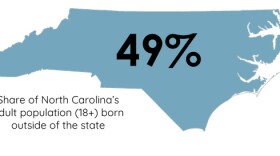North Carolina's population – predictably – increased in 2017. This marks the 65th consecutive year of growth and puts North Carolina at nearly four straight decades in which it significantly outpaced national growth.
If anything, the growth actually accelerated this year. North Carolina's population increased by 116,730 from 2016 to 2017, the largest year-over-year increase this decade, Census Bureau figures released this week.
In percentage terms, the population increased by 1.15 percent, which was also the highest gain this decade. In some ways, the percentage growth stands out even more since it builds on a higher base from year to year as the population continues to grow.

The growth confirms that North Carolina will almost certainly gain a Congressional seat in 2020, giving this state 14 seats. States in the Northeast and Midwest will likely lose Congressional seats, while those in the South and West will pick them up, by Carolina Demography, part of the UNC Population Center. The only exception is Alabama, which might lose a seat.

North Carolina's population growth vaulted it past Michigan in 2014 and the Tar Heel state now ranks ninth in terms of population size. Moving to eighth will be difficult, however. Georgia currently ranks eighth, and while Georgia's population is only about 156,000 higher than North Carolina's, it is actually growing slightly faster than North Carolina when looking at a three-year or five-year average. Ohio currently ranks as the seventh most populous state, but it would take North Carolina more than 16 years to catch up to Ohio's 11.7 million population at the current growth rate of both states.










